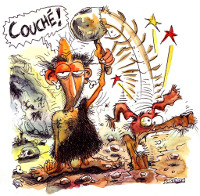 |
Violence with dogsBeing violent with your dog: why it's such a bad idea. |
We've all lost our patience at least once when our dog refused to obey us. But contrary to popular belief, being violent doesn't help us get our point across!
When a young dog does his business in the wrong place, we often stick our noses in it to “make him understand that it's wrong”. And if he does it again, it's because he's a “bad dog”, so we scold him harder... This is one of the many preconceived ideas about the value of violence in training our dog. However, we can see that we rarely get what we want by acting in this way. Dog obedience should not be confused with owner domination.
Violence brings very limited results.
What we often take for provocation or even recidivism on the part of our canine friend, is in reality that our order is not clear and our dog, lost, no longer knows what he should do. For example, when we scold him for relieving himself in the apartment, the dog understands “I must not urinate in front of my master” and will act as soon as your back is turned! If it's more than the occasional mischief, we need to understand the reason why our dog disobeys.
As behaviorist veterinarian Gérard Muller explains in his book Mon chien n'obéit pas (published by Eyrolles), a dog is above all an animal descended from the wolf, meaning that social status within the “pack” is central. So, he tests our resistance in the most strategic situations, such as mealtimes and sleeping areas, in order to become the leader of the pack. So it's up to us to set him clear limits so he doesn't pick up bad habits. But this can be done without force.
What's the right thing to do?
“The only function of authority over your dog is to set a reassuring framework. Violence is therefore counter-productive, because dogs need to feel secure and in their place. There are several ways of making him obedient:
- Think about what we want to achieve: Our request must be made clearly and with a determined tone, so that the dog understands he has no choice.
- Give commands more often: we only give commands in important situations. This should be a regular occurrence, so that it doesn't become a tense moment. Orders should be given in a playful way, for example in a neutral tone of voice, accompanied by a gesture of encouragement. Example: Give the command to lie down with a gesture towards the floor or the crib. It's very important to reward and praise good behavior.
Your dog wants to please you and will reproduce the behaviors that make you happy. A “good dog” accompanied by a caress is more pleasant than a command given without a friendly or emotional reward. Let's put ourselves in his shoes.
- The dog needs to feel that he can't test the limits of other family members. So, in accordance with the rules imposed, the dog has no choice but to accept.
If he has to be punished for something he's done wrong, it's better not to look at him or talk to him for several minutes or an hour, and to ignore him rather than punish him with violence. Isolation from the family is not good for either dog or human. Isolation time should not exceed one day to avoid traumatizing your dog. We want to punish him, not stress him further.






 English (United Kingdom)
English (United Kingdom)